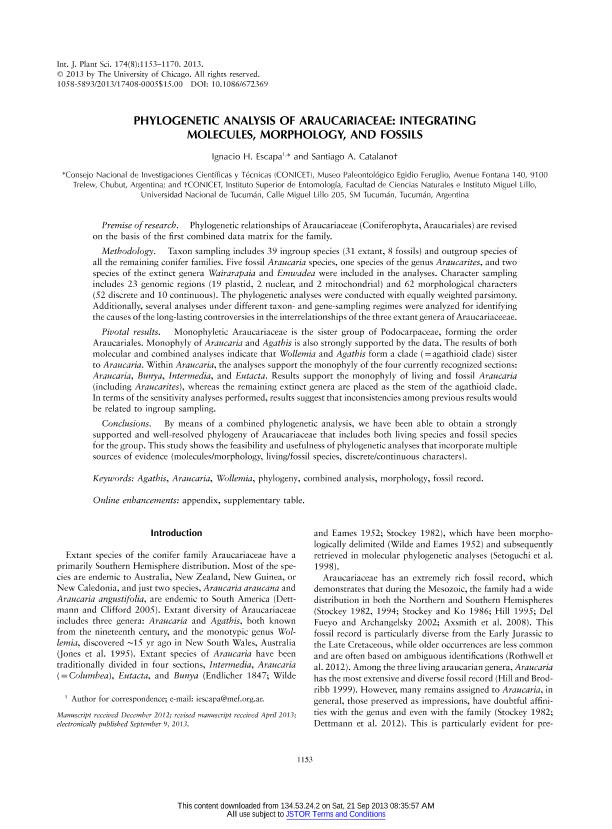Mostrar el registro sencillo del ítem
dc.contributor.author
Escapa, Ignacio Hernan

dc.contributor.author
Catalano, Santiago Andres

dc.date.available
2016-01-13T17:28:41Z
dc.date.issued
2013-09
dc.identifier.citation
Escapa, Ignacio Hernan; Catalano, Santiago Andres; Phylogenetic Analysis of Araucariaceae: Integrating Molecules, Morphology, and Fossils; University of Chicago Press; International Journal of Plant Sciences; 174; 8; 9-2013; 1153-1170
dc.identifier.issn
1058-5893
dc.identifier.uri
http://hdl.handle.net/11336/3583
dc.description.abstract
Premise of research: Phylogenetic relationships of Araucariaceae (Coniferophyta, Araucariales) are revised on the basis of the first combined data matrix for the family.
Methodology: Taxon sampling includes 39 ingroup species (31 extant, 8 fossils) and outgroup species of all the remaining conifer families. Five fossil Araucaria species, one species of the genus Araucarites, and two species of the extinct genera Wairarapaia and Emwadea were included in the analyses. Character sampling includes 23 genomic regions (19 plastid, 2 nuclear, and 2 mitochondrial) and 62 morphological characters (52 discrete and 10 continuous). The phylogenetic analyses were conducted with equally weighted parsimony. Additionally, several analyses under different taxon- and gene-sampling regimes were analyzed for identifying the causes of the long-lasting controversies in the interrelationships of the three extant genera of Araucariaceeae.
Pivotal results: Monophyletic Araucariaceae is the sister group of Podocarpaceae, forming the order Araucariales. Monophyly of Araucaria and Agathis is also strongly supported by the data. The results of both molecular and combined analyses indicate that Wollemia and Agathis form a clade (=agathioid clade) sister to Araucaria. Within Araucaria, the analyses support the monophyly of the four currently recognized sections: Araucaria, Bunya, Intermedia, and Eutacta. Results support the monophyly of living and fossil Araucaria (including Araucarites), whereas the remaining extinct genera are placed as the stem of the agathioid clade. In terms of the sensitivity analyses performed, results suggest that inconsistencies among previous results would be related to ingroup sampling.
Conclusions: By means of a combined phylogenetic analysis, we have been able to obtain a strongly supported and well-resolved phylogeny of Araucariaceae that includes both living species and fossil species for the group. This study shows the feasibility and usefulness of phylogenetic analyses that incorporate multiple sources of evidence (molecules/morphology, living/fossil species, discrete/continuous characters).
dc.format
application/pdf
dc.language.iso
eng
dc.publisher
University of Chicago Press

dc.rights
info:eu-repo/semantics/openAccess
dc.rights.uri
https://creativecommons.org/licenses/by-nc-sa/2.5/ar/
dc.subject
Agathis
dc.subject
Araucaria
dc.subject
Wollemia
dc.subject
Phylogeny
dc.subject
Combined Analysis
dc.subject
Morphology
dc.subject
Fossil Record
dc.subject.classification
Genética y Herencia

dc.subject.classification
Ciencias Biológicas

dc.subject.classification
CIENCIAS NATURALES Y EXACTAS

dc.subject.classification
Ciencias de las Plantas, Botánica

dc.subject.classification
Ciencias Biológicas

dc.subject.classification
CIENCIAS NATURALES Y EXACTAS

dc.title
Phylogenetic Analysis of Araucariaceae: Integrating Molecules, Morphology, and Fossils
dc.type
info:eu-repo/semantics/article
dc.type
info:ar-repo/semantics/artículo
dc.type
info:eu-repo/semantics/publishedVersion
dc.date.updated
2016-03-30 10:35:44.97925-03
dc.journal.volume
174
dc.journal.number
8
dc.journal.pagination
1153-1170
dc.journal.pais
Estados Unidos

dc.journal.ciudad
Chicago
dc.description.fil
Fil: Escapa, Ignacio Hernan. Museo Paleontológico Egidio Feruglio; Argentina
dc.description.fil
Fil: Catalano, Santiago Andres. Universidad Nacional de Tucumán. Facultad de Ciencias Naturales e Instituto Miguel Lillo. Instituto Superior de Entomología; Argentina. Consejo Nacional de Investigaciones Científicas y Técnicas. Centro Científico Tecnológico Tucumán; Argentina
dc.journal.title
International Journal of Plant Sciences

dc.relation.alternativeid
info:eu-repo/semantics/altIdentifier/url/http://www.journals.uchicago.edu/doi/abs/10.1086/672369
dc.relation.alternativeid
info:eu-repo/semantics/altIdentifier/doi/http://dx.doi.org/10.1086/672369
dc.relation.alternativeid
info:eu-repo/semantics/altIdentifier/issn/1058-5893
Archivos asociados
